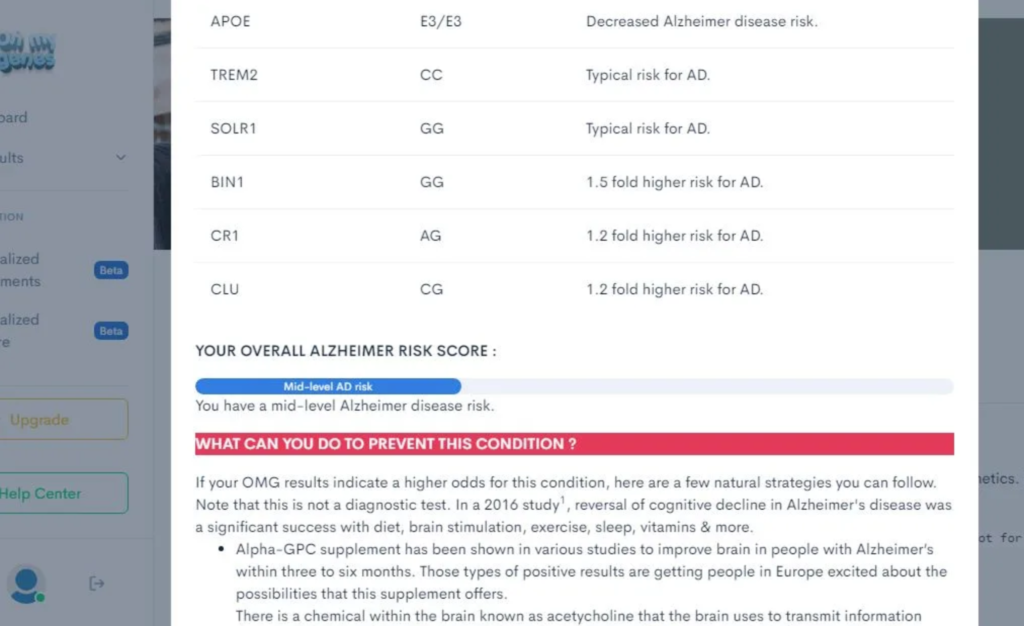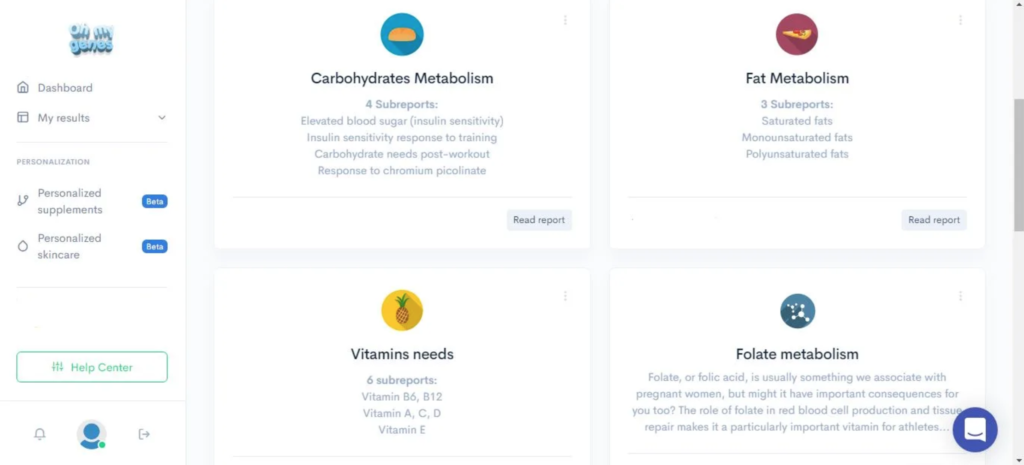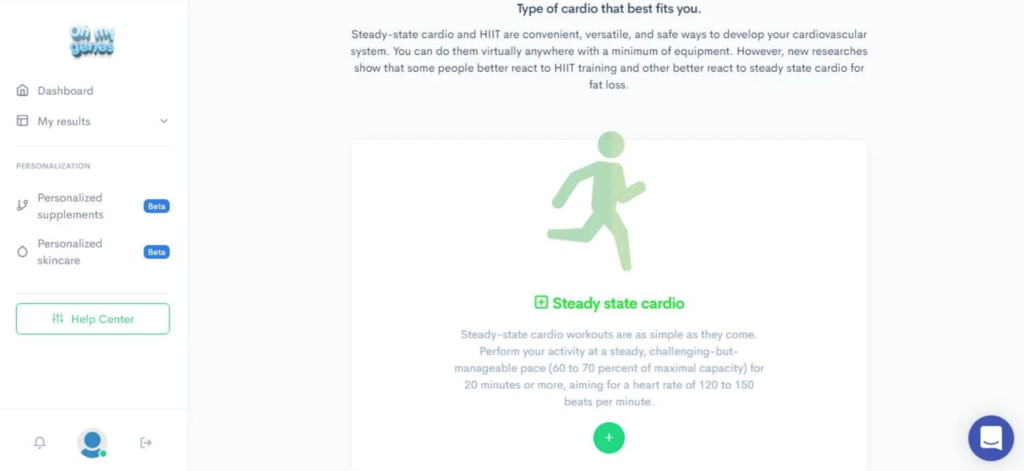
A microbiome test? New scientific research into gut bacteria (called microbiome) is gaining a massive popularity. They show that our living microorganisms in our gut take part in nearly every aspect of our health and wellness. Therefore, knowing more about our microbiome composition could help us being healthier by regulating our good and bad bacteria through foods and probiotic supplements.
A DNA test? On the other side, the growing research on human DNA is also gaining a huge popularity. Today, we know that human DNA can tell you an extremely high level of information you might want to know—such as your ancestry composition (where you come from?), which diseases you are predisposed to have in the future, or which medication is going to give you serious side effects, even before trying them.
A combination of both? That’s why Oh My Genes, a recently lauched company, created the world’s first artificial intelligence learning system in order to analyse both your DNA and your microbiome. The goal is to give you a deeper insight about YOU, your ancestry composition, and better recommendations for a better health and wellness. I have recently tried their DNA + Microbiome test and reviewed it.
Table of Contents
How does Oh My Genes work?
After you purchase your Oh My Genes service on their website, you’ll receive two kinds of kits: a saliva collection kit and a stool collection kit. The saliva one is for the DNA and oral microbiome test. The stool one is for the gut microbiome test. After collecting your samples, you just have to mail your samples back into Oh My Genes lab. Just wait few weeks and receive your results on your Oh My Genes account (on their interactive web-app).
Summary of the results
First impression: Wow! The amount of information and details given is huge.
- My ancestry report
In summary, the Oh My Genes at-home DNA test gave a great understanding of my ancestry composition. It provided me lot of details about my ethnicity which is highly adequate with my own research I have done ahead of time.
It told me that the large part (98,2%) of my DNA was from Europe. When entering in details: 79,4% was from ‘West & North Europe’ which was then divided into the 69.2% “English” and 10.2% “Welch, Scottish and Irish”. These results clearly impressed me and at the same time surprised me because Oh My Genes had been able to seperate the English aspects of my ethnicity from the rest of the British Isles. My grandfather was Irish, therefore it was so great to notice this aspect of my ethnicity.
- My diseases reports
For most of the illness analysed, my odds were lower than average, and I was so surprised to see how accurate they were. One of the diseases they had warned was migraine. I actually do suffer from this condition from time to time. The median risk of having migraine was given as 39%, while my own likelihood was at 61%, which made sense.
One of my results really surprised me: my probability of having Alzheimer’s in the future was very high (being 89% as opposed to 19%). This result looks accurate because I’ve had at least two grandparents with this condition. The recommendations that could prevent were to stay physically and mentally active by doing activities like reading books, playing brain games such as puzzles or chess, learning new things, and memory exercises. It also included some supplements as a prevention strategy such as Alpha-GPC. All these recommendation can help me growing my reserves of brain cells and help to prevent the development of Alzheimer’s.

- My gut microbiome reports
There is an other interesting section called “Microbiome profile”. My microbiome composition was rated as two out of 5 and red on the scale (meaning a warning sign).
Various other ratings played a part in the overall Microbiome rating: “Vitamin production”, “Illness Protection”, “Dietary fiber needs” and “Microbiome variation”. I was rated seven out of 10 for all but Microbiome diversity, which was four out of 10.
We can see in this section a plenty of reports. One of these is the “Butyrate production from dietary fiber intake” report. It started by an introduction part which gives an explanation of the process: when fiber is broken down, our bacteria create butyrate from it, an anti-inflammatory fat that helps our gut work right and protects against disease. It was great to learn that my microbiome’s is potentially able to process fiber and synthesize butyrate efficiently.
In the recommendation part, eating foods that expand my microbiome’s fiber metabolism is advised. The scientific references to academic papers that strengthen these advices elevated my confidence in their useful outcomes.
My Vitamins production results were equally encouraging. The report revealed that my bacteria had a great ability to synthesize the range of vitamins included (nine in total).
Unluckily, my Microbiome Diversity results told me that my bacteria was less diverse than average. It seems that it could be due to a poor diet, a recent use of antibiotics or an intestinal disorder. I had not recently use any medication neither any antibiotic, but that’s true that my diet was not on point. Therefore, various nutritional recommendations had been incorporated, as for the fiber results (shown below).

The detailed explanation for this report was one the best I’d come across. It straightforwardly explained that a balanced mixture of bacteria is an indicator of good health, whereas a microbial imbalance gave rise to a condition called dysbiosis, which was often a precursor of disease.
To conclude, this section gave a lot of information about multiple details of my microbiome and there was plenty to explore. All food recommendations were very helpful and I am going to incorporate them into my regimen as soon as possible.
- Nutrition reports
These reports also included some microbiome results.
One of the section in the Nutrition reports provided information about my high sensitivity to carbohydrates. It was simple and clearly explained using a table to reveal each of the genetic marker and bacteria analyzed and the outcomes. At first, it seemed a little complex, but once I started reading, it was really simple to understand. Various actionable recommendations were given, for example advising me to add 7% of my daily calories as refined carbohydrates. It was very detailed, but not overwhelming.
I was impressed with the extensive amount of information provided, just for that one result, but was even more impressed that at no point did it seem too complex or scientific.
All following reports were approximately the same – I learned that I should increase my daily proportion of antioxidants foods to compensate my low capacity of neutralizing free radicals, and that I should reduce my salt intake due to the fact that I am very sensitive to it. Once I finished reading all of my reports I concluded that I hadn’t just received more information about my own nutritional needs, but also gained a lot of precious knowledge about nutrition in general.

- Training reports
After reading my Nutrition Reports, I moved on to see how my genetics might affect my workout.
According to the results, I have quiet rare genetic variants that we can see in only 9% of the population. These genes are associated with low levels of body fat in response to strength training. I used to doing more endurance type workout and now I will definitely focus more on strength workouts.
In the second part of the report, I found out that this same genetic variant was related to levels of a protein called “myostatin”. Not only is this protein related to a lower body fat in reponse to strength exercise, but it is also associated to a significantly higher muscle mass and overall muscle building capacity. This is a very rare gene variant according to them.
There are a lot of other results such as ‘Lactate threshold’, ‘Training response to hypoxia’, ‘Injury prevention’, ‘HIIT cardio vs Steady state cardio’, etc.. I was surprised to read that I am not a high responder to low intensity steady-state cardio and that I rather needed high intensity cardio to get more fat loss effects (also called HIIT). Steady-state cardio workouts are as simple as they come. Perform your activity at a steady, challenging-but-manageable pace (60 to 70 percent of maximal capacity) for 20 minutes or more, aiming for a heart rate of 120 to 150 beats per minute. HIIT workouts are slightly more complex. Perform your activity as hard as you can (90 to 100 percent of maximal capacity) for a brief, set time period (usually two minutes or less), then back off for a predetermined rest interval (usually three minutes or less), and repeat the cycle four times or more.

- Skin report
The first result covered in the skin report was hydration. It was surprisingly great to learn that I am not genetically predisposed to a good skin hydration level. And that’s 100% true. I always get a dry skin, especially during the winter. First, I thought that perhaps this was the consequence of an environmental factor but now I pleased to know that it was a genetic factor.
Next, I looked at my Elasticity results. In the introduction, I learned that it was mainly to do with the ratio of collagen production versus collagen breakdown. Four genes are tested for this report: MMP9, MMP1, IL6 and MMP3. They all are involved in the collagen renewal process and collagen degradation process. Various scientific studies that had demonstrated links between these genes and elasticity were also mentioned. The result showed me that my skin’s capacity to limit collagen destruction and inflammation processes was “significantly reduced”.
The next reports were about “glycation”, “free radical damage”, “sun damage & pigmentation”, “inflammation”. They all provided very interesting insights about my skin.
- Medication reports
It was pleased to see that approximately 90% of the medications listed were in the green category, meaning that I was most likely to metabolise and respond to them in a normal way. This summary of results is a must-have in your life so you can avoid various and serious side effects if you are on medication one day, using them with caution.
These involved medication that I have to use carefully due to a reduced metabolism (Voriconazole, Losartan, Carisoprodol, Caffeine, Lacosamide, Diazepam, Olanzapine) and one with extreme awareness due to a significant reduction in the metabolism (Clopidogrel). I don’t know any of these drugs, except the caffeine one. I regularly drink four or more shots of coffee a day so it was an interesting topic for me. I learned that I metabolize caffeine very fast.
I thought perhaps it is a bad news and so perhaps I needed to reduce my coffee intake. But it wasn’t the case at all. After looking at the ‘Recommendations’, I realised that it was the opposite. This actually meant I was less likely than average to have a ‘heart attack’ from it due to the fact that my body excretes the caffeine very fast from my blood. I didn’t understand why this has been flagged up as a molecule to use with caution but I was happy to learn that I didn’t need to give up my coffees break!
Each report had at least one supporting scientific study, which is impressive. The only result shown as red (meaning that I should use it with extreme caution) was the Clopidogrel. I learned from the report that this medication is for people who had suffered from a stroke or heart attack. The goal is to avoid the development of blood clots. This results could be helpful to me in the near future as my relatives have suffered from heart problems.
CONCLUSION
In summary, I’m really glad I took the Oh My Genes test. I was particularly impressed that it contains so useful information and easy-to-follow recommendations.
I’d highly recommend this test. It was interesting to read, and I felt that it was likely to be a valuable tool for helping me stay as healthy as possible, both now and in the future.